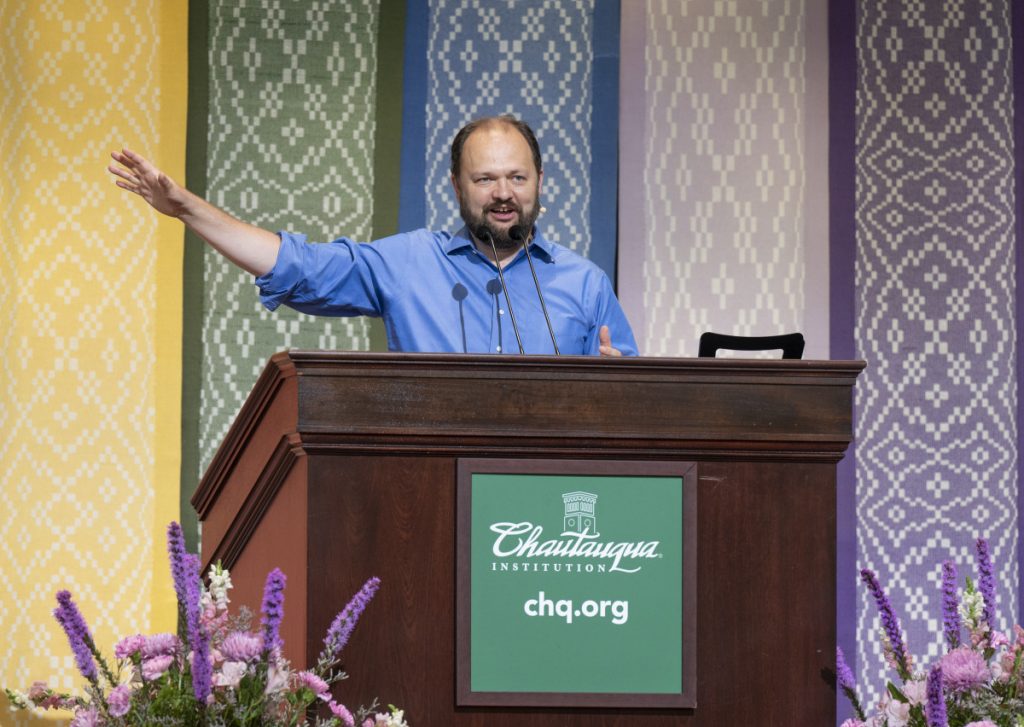MAX ZAMBRANO – STAFF WRITER

Going off ideas from the rest of the week, New York Times opinion columnist Ross Douthat began his lecture with the notion we are living in a time comparable to when Chautauqua was founded in the late-19th century.
“This is an age of unfettered capitalism, a new Gilded Age in which robber barons get rich and build spaceships instead of libraries and summer cottages, inequality runs rampant, political parties are corrupted by money, journalism is corrupted by partisanship and the poor never get their fair share,” he said.
Except Douthat sees a big difference.
“The Gilded Age was during an era of true dynamism — an era of radically increasing abundance and technological transformation that set the stage for reformers,” he said.
The current era, instead, is defined not by dynamism, but by deceleration and stagnation, Douthat said.
Douthat explored this idea in his lecture “Secularism and Stagnation: How Our Economy Became Decadent,” the final Week Seven Interfaith Lecture Series themed “Creating an Economy that Works for All” on Aug. 11 in the Amphitheater.
This deceleration began slightly before the moon landing, Douthat said. Since 1492, the global economy doubled in size every century, but it went down to a 2% annual growth by the 1960s, he said.
“That breakpoint in the ‘60s had immediate economic consequences,” he said.
Douthat listed hourly wages peaking in the United States in the 1970s, household income growth slowing down and three recessions during the Nixon, Carter and Reagan presidencies.
Lower taxes, deregulation, free trade, increased immigration and anti-inflation policies might be described as neoliberalism, Douthat said, or economic policies under Reagan, Bill Clinton and British Prime Ministers Margaret Thatcher and Tony Blair.
The initial response seemed to work, Douthat said, as growth returned to about 4% annually by the late 1990s. Productivity growth, which he said is the best measure of technological change working and impacting the economy, boomed after the internet’s birth.
Then, the dot-com bubble burst, he said.
“Thereafter, you had a long period carrying on toward the present day of weak recoveries, weak household income growth, declining productivity and far more workforce dropouts than before,” he said.
Deceleration followed by stagnation happened across the developed world, from the United States to Europe to East Asia, Douthat said. Although levels of dynamism vary from country to country, and the United States still has more than other places, it’s not as much as the cliche of American exceptionalism, he said.
During the Carter presidency, which Douthat said was far from an ideal time in America’s economic history, 15% of businesses were founded in the administration’s last year. The rate today is around 8% and is lower still with the COVID-19 pandemic, he said.
Moreover, the number of startups that failed in the first year increased from 20% to 30% in the last few decades, he said. The percentage of new firms overall is down by one-third, and successful corporations sit on their money or pass it back to shareholders, opting against funding for inventions and innovations.
“This isn’t really an age of robber barons exploiting workers, but building big corporations while they do it,” he said. “It’s an age of vanguard accounts for the upper class and hedge funds for the super-rich recirculating wealth, but not necessarily creating broad prosperity and dynamism.”
Today, Silicon Valley and companies like Amazon, Google and Apple can thrive while pricing out the middle and working class, while big factories in the Rust Belt relied on huge workforces, Douthat said. Big companies hire less than they once did, hindering the American quality of wanderlust, he said.
“There’s this idea that the modern word is full of churn and nobody stays put anymore, but, in fact, Americans move less now,” he said. “They no longer go west or east or north or south in search of opportunities. The rate at which people move between states has fallen since the ‘70s by more than half. Nor do Americans actually change jobs as much as they once did.”
Populist surges, right-wing revolts and left-wing socialist alternatives in America and Europe are political crises connected with the economy, Douthat said. Neoliberalism is commonly blamed as something that was beneficial in the late-20th century but is now harmful, he said.
Free trade hollowed out Western economies, low tax rates enabled the rich to keep more of their gains and antitrust policies became more focused on the benefits of consolidation to consumers, he said.
With inflation, policies in the 1970s impacted the 2008 financial crisis, Douthat said, because economies didn’t spend enough money to pull themselves out of the recession sooner.
Similarly, a libertarian perspective is that a captured economy, including land use rules, zoning rules, occupational licensing, expanding property protections and corporate subsidies and tax breaks, has created a system that can simultaneously bring out the worst of socialism and capitalism, he said.
“Those stories are depressing, but also kind of encouraging because they imply there are solutions to stagnation,” Douthat said.
Some of those solutions might include weakening monopolies, taxing the wealthy and cutting welfare and subsidies that flow to big corporations and the rich, he said. Perhaps ironically, both the Trump and Biden administrations have shifted from the economic consensus of the last 30 to 40 years, Douthat said.
“The Biden administration has kept a lot of the Trump administration’s tariffs and protectionist policies,” he said.
Some of the Trump-era policies did help achieve one of the best economies with relation to overall growth and wage growth for the working class in the last 20 years, Douthat said, while noting this was upended by the pandemic.
Both administrations ran and are running with significantly high deficits, he said — which might be necessary, but is not creating organic innovations or job growth.
“Certainly there is some kind of limit at some point,” he said. “When we hit that limit, we could go back to a ‘stagflation’ scenario, having made a pilgrimage back to 1975 without finding a way out.”
Douthat argued we are in a time of secular stagnation, with secular meaning a trend that isn’t cyclical.
“It’s just stagnation that persists no matter what policymakers do over a long period of time,” he said. “There’s a good chance that is the story.”
He suspects the type of growth seen in the late 1800s will not be repeated, because innovations would be defensive against climate change. He described it as a payback for growth during the industrial revolution.
New innovations have been slow because of technological stagnation, too, he said. Although there are obvious marvels such as the iPhone and internet, there’s been less growth in areas like energy, transportation, agriculture and communication.
“People worried that robots would take all of our jobs,” he said. “Actually, the problem is they aren’t taking our jobs.”
Sometimes it takes a big spark to reignite innovation, he said. Perhaps COVID-19 will be seen as the next great spark considering the rapid medical innovations seen, he said.
There’s no guarantee that’s the truth, though, and there’s no promise stagnation will end, Douthat said.
“A stratified economy where people are getting rich but not doing more innovative forms of entrepreneurship is more likely to want to freeze the economic order and resist creative destruction,” he said.
It’s also harder to refit infrastructure in an economy based on deficit spending, which he said is why self-driving cars are hard to invent — it also requires rebuilding an urban ecosystem fit for them.
One trend of the modern developed world that impacts the economy is fewer births, Douthat said.
In order to replace one generation with another, a country must average 2.1 births per woman. Five years ago, the European Union averaged 1.6 births, Japan averaged 1.4, South Korea averaged 1.2, Singapore averaged 0.82, Canada averaged 1.6, Australia averaged 1.7, and the United States averaged 1.87.
America is most recently at 1.6 births since the pandemic began.
Some explanations exist, he said, such as a lower infant mortality rate lowering the incentive for having as many children as possible, an information economy making children less valuable as household laborers and more expensive because of the price of education.
Additionally, birth control has lowered the number of accidental pregnancies, the feminist movement created strong incentives to delay childbirth, more divorces meant fewer people were in relationships to have children and older people had more protection with welfare.
People do want more children, though — Douthat said the desired family size is around 2.5 children.
“We should care about the fact that the desired family size and actual family size is so far apart because it suggests it isn’t just free people making free choices — but modern society is failing to supply the cultural, economic and religious foundation for people who want kids to do it,” he said.
Lower birth rates also lead to aging societies with fewer workers, slow GDP growth and leaves less room for dynamism, he said.
Regarding climate change, less dynamism and an older society means new innovations may only delay its worst effects, while a younger society could eliminate fossil fuels faster, Douthat said.
In the 2013 book Capital in the Twenty-First Century, author Thomas Piketty argued capitalism was leading to the success of the 1%, Douthat noted. Low population growth, Piketty argued, aids in their success because fewer children means fewer heirs to divide the wealth.
Lower birth rates and smaller families means people are spending more time alone, which may feel freeing between ages 18 to 35, but then people risk isolation into middle age and elderly years, Douthat said.
“The advantage of living solo and the promise of independence becomes a curse,” he said.
The absence or delay of children leads to another absence or delay of grandchildren, removing purpose and optimism from people’s lives, he said.
When all of this began in the 1960s, so too began the modern wave of secularization, Douthat said, with increasingly weakened or nonexistent ties to religion being a part of society. There was also the idea that religion and science could go together, such as the case of Chautauqua’s founding. Religious ideas and moral values were separate from growth and innovation, he said, instead being a way to gentle capitalism.
That could still be true, he said, but perhaps religion can also be a source of creativity and dynamism.
“Religious revival, in this sense, wouldn’t just be a way to tame inequalities associated with growth — it would be a way to generate more of that growth in the first place and tame inequalities that are more associated with stagnation,” he said.
Douthat’s conservative friends focus on an unrealistic notion of everyone turning to traditionalist values, which creates a vision of those traditionalist people being converted for the purpose of secular producers and consumers, he said.
Instead, Douthat wants to imagine a world where broad religious ideas — like God creating the universe and humans participating in God’s divine plan, to specific ideas of babies being good — can create a society of moral institutions that are concerned with social justice more than acquisition.
“At a fundamental level as far apart as science and religion can go, both scientific and religious experiments proceed from a similar desire of knowing,” he said, adding they both seek to understand the universe’s secrets.
He said this relationship between religion and science, between modern dynamism and ancient faith, can steer society away from stagnation.
“There can be a mysterious alchemy between different forms of human exploration,” he said. “I think nothing will be a surer sign that our age of stagnation is really ending than that kind of alchemy suddenly returning.”




